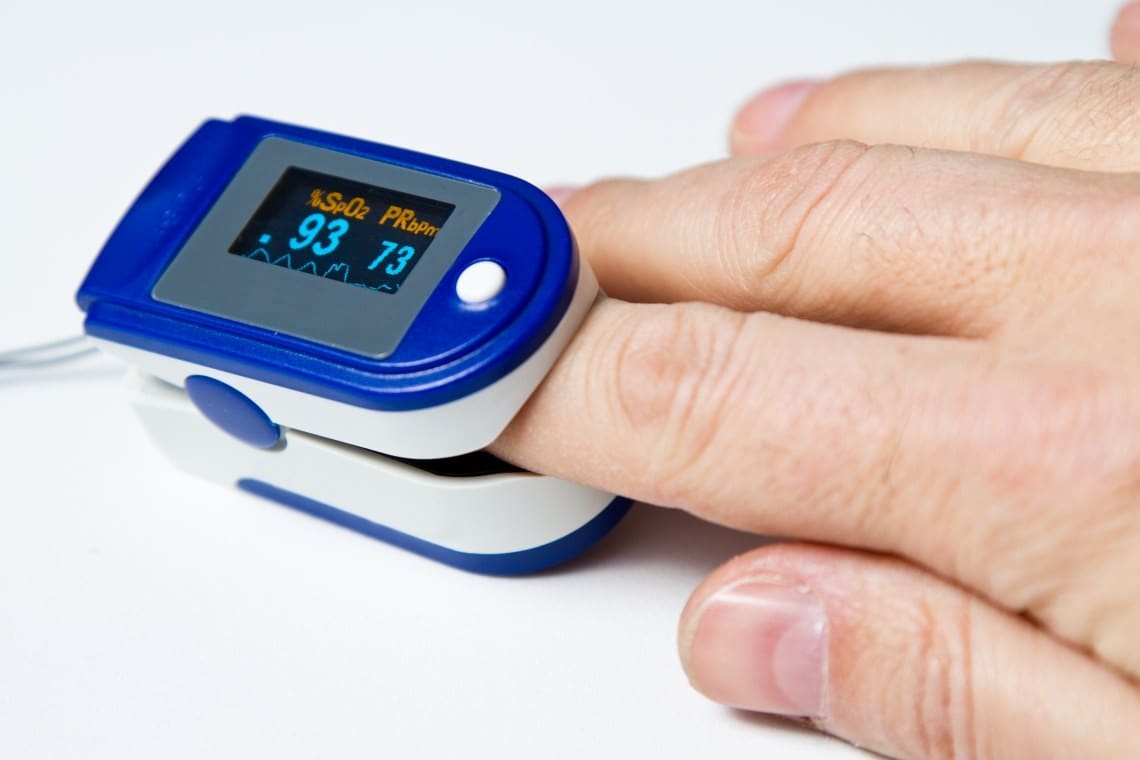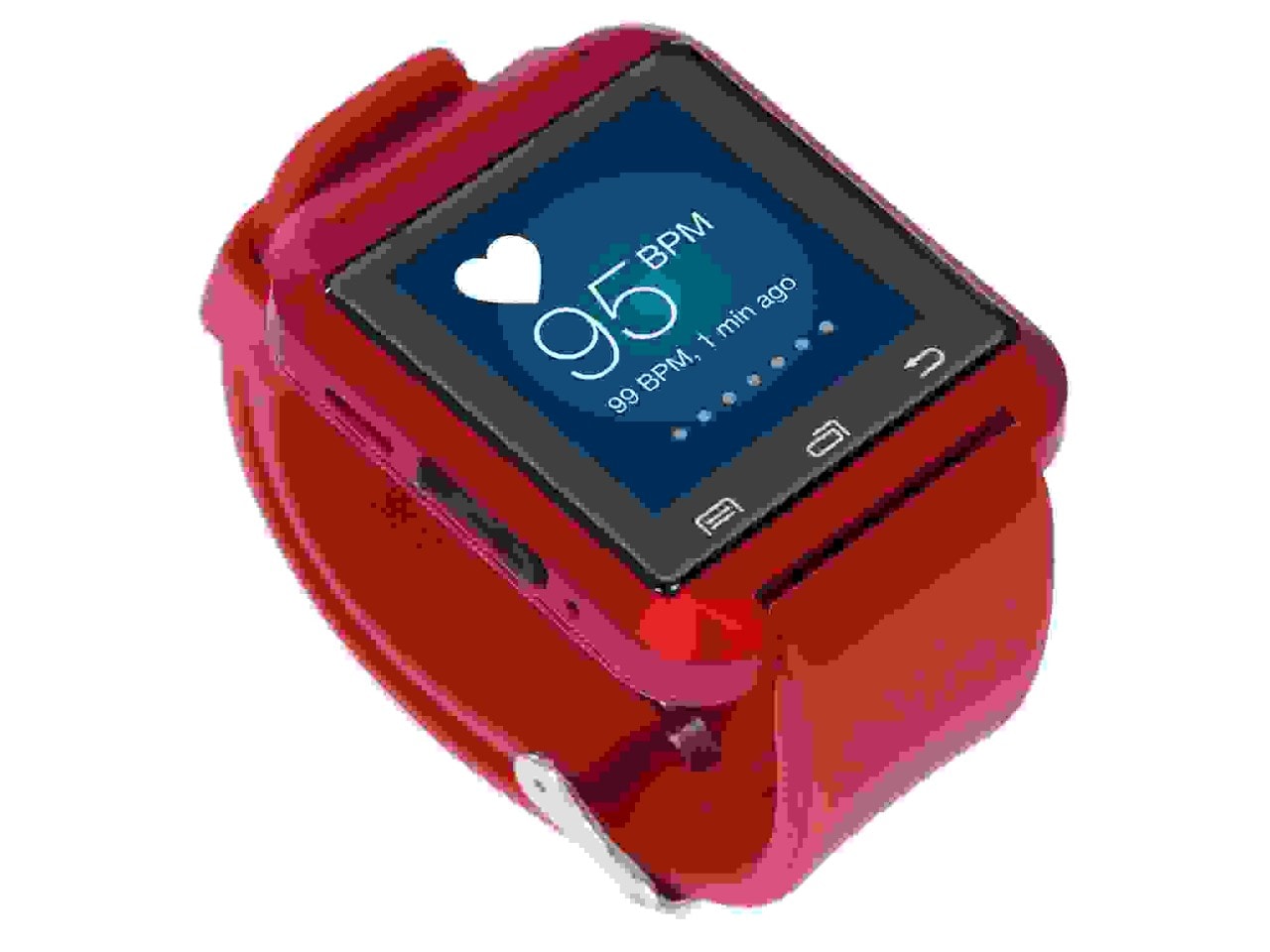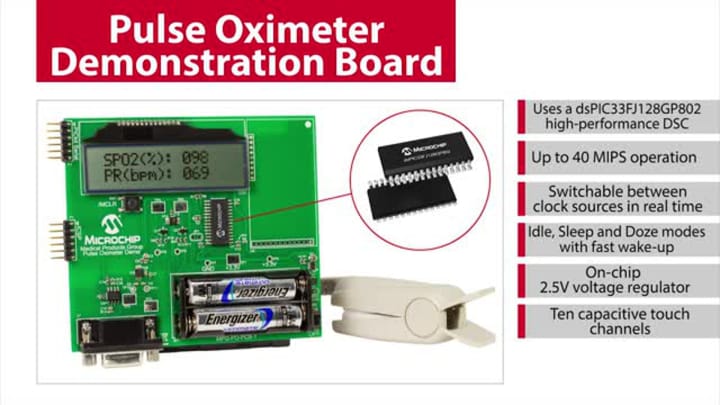A pulse oximeter is a non-invasive electro-optical device for measuring both the heart rate and the degree to which the hemoglobin in one’s blood has been saturated with oxygen. This quantity is inferred by measuring the optical transmittance of perfused skin in different wavelengths of light. Red, green and infrared LEDs are convenient and common light sources. Blood oxygen saturation can be determined by comparing the values of Oxy-hemoglobin to Deoxy-hemoglobin. One method for doing this is by shining both a red LED and an infrared LED into a body part (such as a finger or wrist) and then measuring and comparing the relative intensities of the light from each LED in terms of a ratio. This ratio is then typically expressed as the percentage of oxygen saturation.
Pulse oximeter designs call for low power consumption and extensive analog and digital filtering. They are often implemented both as stand-alone medical and fitness devices as well as components of more comprehensive vital sign monitoring systems.
Pulse Oximeter Demo Design Files

Pulse Oximeter Demo Design Files
Check out the design files for a low cost, high-performance pulse oximeter demo.

Single-Chip Wearable Heart Rate Monitor Demo Design Files
Check out the design files for a single-chip, wearable heart rate demo.
Microchip's Pulse Oximeter Demonstration Board
Microchip’s pulse oximeter reference design demo board helps designers develop a low-cost, low power handheld or wearable pulse oximeter with user interface which is capable of measuring both heart rate and blood oxygen level. It can be used to start development of a hospital or clinical pulse oximeter design, but it can also be used as a starting point for the development of a wearable activity tracker design that can measure heart rate and blood oxygen level.

Wearable Heart Rate Monitor Demo
Our reflective Wearable Heart Rate Monitor Demonstration Board shows how heart rate can be measured using only a single 8-bit microcontroller (MCU). The demonstration board utilizes a Phase Division Multiplexing technique to simultaneously measure multiple signals with zero cross talk.

System Diagram
We Have What Pulse Oximeter Designers Need
Products
Microcontrollers
Signal Conditioning and Power Management
Wireless
Other Products
Application Notes
|
Title
|
|
|---|---|
| AN951 - Amplifying High-Impedence Sensors Photodiode Example | Download |
| AN1906 - Bluetooth Low Energy Digital Pedometer Demo Design | Download |
| AN1661 - Sensor Calibration on SSC7102 Bosch Sensor Fusion Solution for Windows 8 | Download |
| AN1525 - Pulse Oximeter Design Using Microchip's Analog Devices and dsPIC Digital Signal Controllers (DSCs) | Download |
| AN1494 - Using MCP6491 Op Amps for Photodetection Applications | Download |
| AN1260 - Li-Ion/Li-Poly Battery Charge and System Load Sharing Management Design Guide With MCP73871 | Download |
| AN1416 - Low-Power Design Guide | Download |
| TB1098 - Low-Power Techniques for LCD Applications | Download |
| ATULPC-DEMO User Guide | Download |
| AN990 - Analog Sensor Conditioning Circuits - An Overview | Download |
Medical Video Channel
Pulse Oximeter Design Solutions

Connected, Secure, and Wearable Electrocardiogram (ECG) Demonstration Video
Connected, Secure, and Wearable Electrocardiogram (ECG) Demonstration Video
As medical remote patient monitoring becomes more important, the need for wearable ECG capability has become critical. Microchip’s Connected, Wearable ECG Demonstration Board can be used in the design of advanced fitness tracking devices and can also be designed into medical wearable remote patient monitoring and diagnostic systems.

Wearable Heart Rate Monitor Demo
Wearable Heart Rate Monitor Demo

Ultra Low-Power (ULP) Connected, Wearable Activity Monitor Demo
Ultra Low-Power (ULP) Connected, Wearable Activity Monitor Demo
High-end wearable activity trackers can take step count, temperature, light and other movement and environment measurements. They are not only being used for fitness applications but are becoming an essential part of medical device design. Microchip’s Ultra Low-Power or ULP Connected, Wearable Activity Monitor Demonstration Board can be used as the starting point for the design of medical home monitoring, patient tracking and drug delivery compliance devices.
For more information, please visit:
https://www.microchip.com/en-us/solutions/medical

Microchip's Wearable Bluetooth® Low Energy Pedometer Demonstration Board
Microchip’s wearable Bluetooth Low Energy pedometer reference design demo helps designers develop a low-cost, low-power, wearable pedometer with both an on-board LED display as well as Bluetooth Low Energy capability to connect to smartphones and tablets. This demo board can be used as a basic wearable step count activity tracker design, but it can also be used as a development platform for the design of more advanced activity tracker functions such as distance traveled or calories burned. Also, additional biometric measurement capability can be added using other Microchip medical reference demo designs.

Microchip’s Connected Thermometer Demonstration
Microchip’s Connected Thermometer Demonstration
Microchip's Connected Thermometer Board demonstrates the implementation of a Bluetooth®-connected digital thermometer using Microchip's PIC16F1519 MCU and RN42 Bluetooth Module. The PIC16F1519 MCU is an eXtreme Low Power (XLP), cost-effective 8-bit microcontroller with an integrated capacitive touch sensing module. Connectivity is demonstrated on this board by the use of Microchip's fully qualified RN42 Bluetooth2.1 + EDR Module. This demo design can also be easily implemented using any of Microchip's Bluetooth Low Energy or Wi-Fi® connectivity modules.

Microchip’s Connected Weight Scale Demonstration
Microchip’s Connected Weight Scale Demonstration
Microchip’s Connected Weight Scale Demonstration Board shows the implementation of a Bluetooth®-connected weight scale using Microchip’s PIC16F1783 MCU and the RN42 Bluetooth module. The PIC16F1783 MCU is an eXtreme Low Power (XLP), cost-effective 8-bit microcontroller with an integrated capacitive touch sensing module, 12-bit ADC and operational amplifiers. Connectivity is demonstrated on this board by the use of Microchip’s fully qualified RN42 Bluetooth 2.1 + EDR module. This demo design can also be easily implemented using any of Microchip’s Bluetooth Low Energy or Wi-Fi® connectivity modules.

Microchip's Pulse Oximeter Demonstration Board
Microchip's Pulse Oximeter Demonstration Board
Microchip’s pulse oximeter reference design demo board helps designers develop a low-cost, low power handheld or wearable pulse oximeter with user interface which is capable of measuring both heart rate and blood oxygen level. It can be used to start development of a hospital or clinical pulse oximeter design, but it can also be used as a starting point for the development of a wearable activity tracker design that can measure heart rate and blood oxygen level.

Health & Fitness Solutions
Health & Fitness Solutions
See how Microchip's products can enable the development of innovative medical and fitness solutions.
More information: https://www.microchip.com/en-us/solutions/medical

Medical Product Solutions from MASTERs 2016
Medical Product Solutions from MASTERs 2016
Get an overview of some of Microchip's solutions for designing the latest medical devices.
More information: https://www.microchip.com/en-us/solutions/medical

Intelligent Analog
Intelligent Analog
Microchip Intelligent Analog PIC MCUs offer on chip analog building blocks with flexible connections to optimize integration, simplify design, and minimize cost.

PIC24F "GC" Intelligent Analog Integration
PIC24F "GC" Intelligent Analog Integration
The PIC24F “GC” family integrates advanced analog features like 16-bit ADC, 12-bit 10 Msps ADC, Dual DAC, Dual OpAmps along with Low Power, USB and LCD. This integration creates and MCU perfect for portable medical and industrial applications.

PIC24F “GC” Based Blood Pressure Meter Demonstration
PIC24F “GC” Based Blood Pressure Meter Demonstration
The PIC24FJ128GC010 powers a blood pressure meter demonstration that utilizes the integrated Intelligent Analog.

Microchip Medical Solutions Demo
Microchip Medical Solutions Demo
This video features a number of medical demos, as well as some innovative new products from Microchip customers.

Connected Functional Safety Syringe Pump/Auto Injector
Connected Functional Safety Syringe Pump/Auto Injector
Whether healthcare is administered in the hospital, clinic or in the home; safe automated syringe pumps and auto injectors have become a critical part of drug delivery. Microchip's Functional Safety Syringe Pump/Auto Injector demo is a great example of the implementation of a medical, safety-critical application. This demonstration highlights the use of Microchip's Class B Functional Safety Software Libraries and our IEC-62304 compliant Functional Safety Compilers. The demo itself not only shows how to design the motor control and sensor interface for an automatic syringe pump or auto injector device, it also demonstrates how to implement connected, patient compliance functions in a drug delivery system.